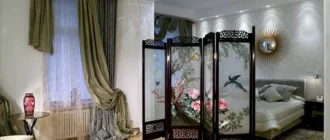
Renaissance is a style of interior design, which is characterized by a combination of symmetry, harmonious proportions and smooth lines, as well as a monumental design of the situation without the use of contrasting colors.
The Renaissance in the interior, as well as in painting, sculpture, literature and philosophy, marked a revival of interest in ancient culture in society. It became a reflection of significant changes in the worldview of people and their rejection of outdated medieval dogmas under the influence of the ideas of humanism.

Features of the Renaissance style in the interior
The Renaissance in the interior showed the world a new concept of interior design in a life-affirming and elegant manner. From Gothic, he inherited organization and logical proportions, but the atmosphere in the house became lighter and more elegant.

The main features
- Symmetry and proportionality of forms with distinct geometric patterns.
- The widespread use of floral ornaments for decorating walls and ceilings.
- A variety of color design of rooms with a predominance of soothing shades and a complete absence of bright contrasts.
- A small number of massive pieces of furniture of the correct geometric shape.
- The predominance in the decoration of expensive natural materials. Vaulted ceilings and walls with rounded niches.
- Curtains made of smooth shiny fabrics, decorated with symmetrical patterns.
- Floors with a strict pattern in the central part of the room, made of natural marble or ceramic tiles.

The Renaissance differs significantly from the Gothic that preceded it in decorative design. The new style borrowed columns and pilasters from the ancient era, but these architectural elements do not perform a practical function, but are only part of the decor.
Wall niches are decorated with frescoes or sculptural compositions made of bronze or marble are placed in them. On the walls of the rooms, paintings or skillful reproductions of Renaissance masters organically look.
In rooms decorated in the Renaissance style, a lot of free space is usually left in the center. The floors are rarely carpeted, and mirrors on the walls are almost nowhere to be found, with the exception of the bathroom. A massive chandelier serves as a source of bright lighting, while wall sconces and table chandeliers complement the luxurious decoration of the house.


Story
The history of the Renaissance style in the interior is inextricably linked with the epochal events that took place in Europe in the XIV-XVI centuries. Italy became the birthplace of new ideas in medieval society, where centers for the development of science began to emerge in many cities at that time, not controlled by the church.
Thousands of artisans and artists who fled from the Ottoman Turks from the Byzantine Empire found refuge here. They brought with them the knowledge and works of art of the Antiquity era, almost completely lost in Europe, which aroused great interest in Italian high society.


Gradually, the innovative ideas of the Renaissance began to spread throughout Italy, which were reflected in all areas of science and art, including interior design. Merchants, bankers and other representatives of the local elite patronized the artists and contributed to the popularization of new cultural values.
There was a demand for decorating the furnishings in the houses of the nobility in a new manner of execution, based on the symbiosis of the traditions of ancient art and the ideas of humanism.
Nowadays, the Renaissance style in the interior can rarely be found in modern houses and apartments.
But the interior of the Renaissance and today remains an ideal option for decorating the decoration of luxury hotels and chic old castles.































